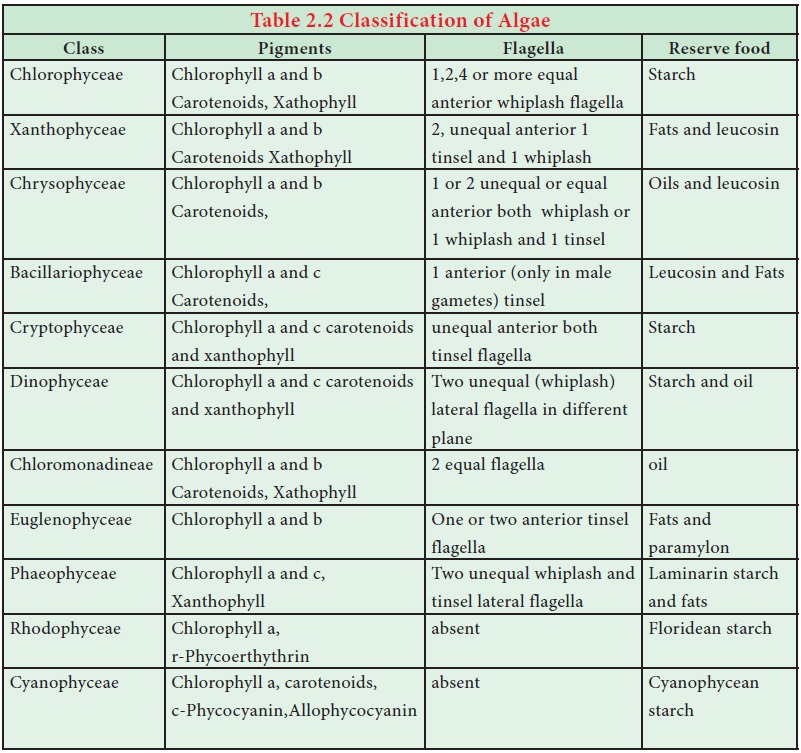Chapter: 11th Botany : Chapter 2 : Plant Kingdom
Classification of Algae
Classification
F.E. Fritsch proposed a classification for algae based on pigmentation, types of flagella, reserve food materials, thallus structure and reproduction. He published his classification in the book “The structure and reproduction of the Algae”(1935).
He classified algae into 11 classes namely
Chlorophyceae, Xanthophyceae, Chryso-phyceae, Bacillariophyceae,
Cryptophyceae, Dinophyceae, Chloromonadineae uglenophyceae, Phaeophyceae,
Rhodophy-ceae, Cyanophyceae (Table 2.2).

The salient features of Chlorophyceae, Phaeophyceae
and Rhodophyceae are given below.
Chlorophyceae
The members are commonly called ‘Green algae’ . Most of the species are aquatic(Fresh water-Spirogyra, Marine -Ulva). A few are terrestrial(Trentipohlia).
Variation among the shape of the chloroplast is found in members of algae. It
is Cup shaped (Chlamydomonas),
Discoid (Chara), Girdle shaped, (Ulothrix), reticulate (Oedogonium), spiral (Spirogyra), stellate(Zygnema), plate like(Mougeoutia). Chlorophyll ‘a’ and
Chlorophyll ‘b’ are the major photosynthetic pigments. Storage bodies called
pyrenoids are present in the chloroplast and store starch. They also contain
proteins. The cell wall is made up of inner layer of cellulose and outer layer
of Pectin. Vegetative reproduction takes place by means of fragmentation and
asexual reproduction is by the production of zoospores, aplanospores and
akinetes. Sexual reproduction is present and may be isogamous, anisogamous or
Oogamous. Examples for this group of algae includes Chlorella, Chlamydomonas,
Volvox, Spirogyra, Ulothrix, Chara and
Ulva.
Phaeophyceae
The members of this class are called ‘Brown algae’. Majority of the forms are found in marine habitats. Pleurocladia is a fresh water form. The thallus is filamentous (Ectocarpus) frond like (Dictyota)or may be giant kelps (Laminaria and Macrocystis). The thallus is differentiated into leaf like
photosynthetic part called fronds, a stalk like structure called stipe and a
holdfast which attach thallus to the substratum.
The Pigments include Chlorophyll a, c, carotenoids
and Xanthophylls. A golden brown pigment called fucoxanthin is present and it
gives shades of colour from olive green to brown to the algal members of this
group. Mannitol and Laminarin are the reserve food materials. Motile
reproductive structures are present. Two laterally inserted unequal flagella
are present. Among these one is whiplash and another is tinsel. Although sexual
reproduction ranges from isogamy to Oogamy, Most of the forms show Oogamous
type. Alternation of generation is present (isomorphic, heteromorphic or
diplontic). Examples for this group include Sargassum,
Laminaria, Fucus and Dictyota.
Rhodophyceae
Members of this group include ‘Red algae’ and are mostly marine. The thallus is multicellular,
macroscopic and diverse in form. Porphyridium
is the unicellular form. Filamentous (Goniotrichum)
ribbon like (Porphyra) are also
present. Corallina and Lithothamnion are heavily impregnated with lime and form coral reefs. Apart
from chlorophyll a, r-phycoerythrin and r-phycocyanin are the photosynthetic
pigments. Asexual reproduction takes place by means of monospores, neutral
spores and tetraspores.
The storage product is floridean starch. Sexual
reproduction is Oogamous. Male sex organ is spermatangium which produces
spermatium. Female sex organ is called carpogonium. The spermatium is carried
by the water currents and fuse with egg nucleus to form zygote. The zygote
develops into carpospores. Meiosis occurs during carpospore formation.
Alternation of generation is present. Examples for this group of algae include Ceramium, Polysiphonia, Gelidium, Cryptonemia and Gigartina.
Related Topics